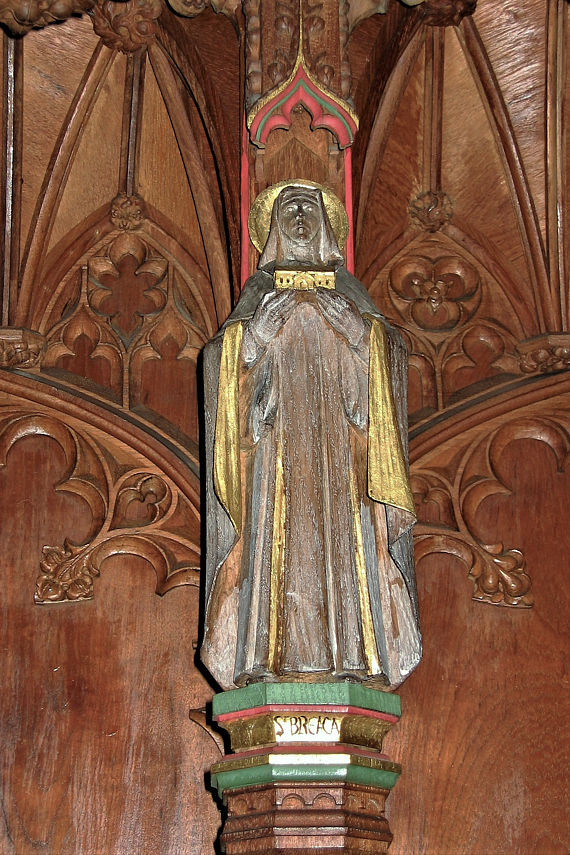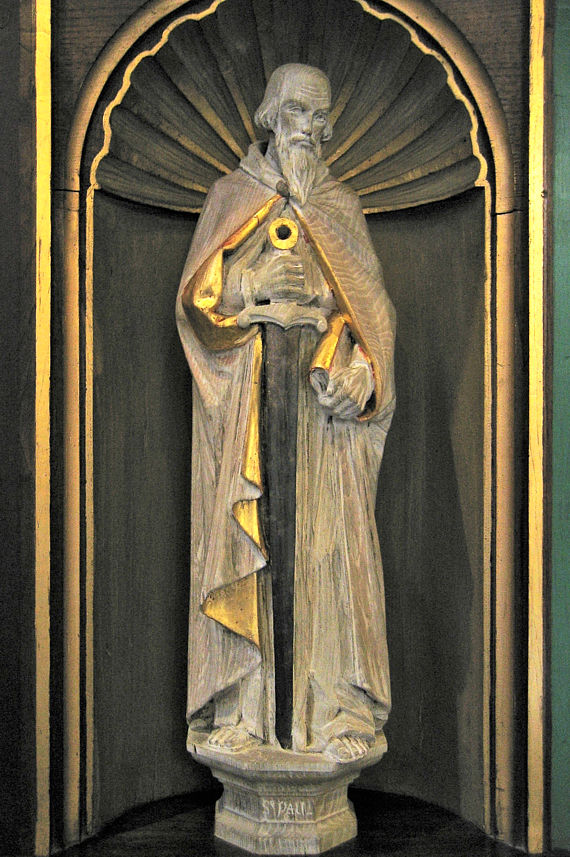Cathedral of the Blessed Virgin Mary
The Diocese of Truro was created in 1876 and its first Bishop, Edward White Benson, appointed in 1877 (Beacham & Pevsner, 2014). He selected the Gothic Revival architect J.L. Pearson to design a new cathedral, and building work began in 1880 and continued in stages until 1910. The interior was also gradually beautified and embellished over many decades, as the dates for pieces by the Pinwill company testify. Violet Pinwill’s greatest achievement at the cathedral was in the carving of 32 figures for the choir stalls, mainly of Cornish saints, for which she carried out extensive research (Goldsmiths College Pinwill Archive 21-24). A full survey of Pinwill woodcarvings in Truro Cathedral was carried out in 2016 by Michael Swift and Mark Evans. Many of the dates attributed below are taken from this report to the Diocese.
Altar Rails – Report (Swift & Evans, 2016); 1920
These rails, situated in the Jesus Chapel, have been identified as being carved by Violet Pinwill. They were given in memory of John Rundle Cornish, Bishop of St Germans, who died in April 1918. There is an unlabelled image of an altar rail in PWDRO 244/4 that bears a striking resemblance but is rather too long.

War Memorial – Photograph (PWDRO 116/88) R.F. Wheatly architect; 1922
The memorial for WWI at Truro Cathedral consists of a desk for a Book of Remembrance backed by panelling on which ‘1914 For Freedom and Mercy and Truth 1919’ (sic) is carved across the top. The bottom left-hand panel is filled with a Latin inscription. According to Chaytor (1990), a magnificent piece of English oak, found in a Totnes timber yard, was used for this work. Swift & Evans (2016), citing Cathedral sources, present a different origin and state that the wood came from the old St Mary’s church, Truro. The panelling was adapted for use as a combined memorial for WWI and WWII. The desk bears the words ‘True Love by Life – True Love by Death is Tried – Live Ye for England – We for England Died’, which was used on several other war memorials carved by V. Pinwill.
Figures for Choir Stalls – Photographs (PWDRO 116/88, 116/117, 244/1, 244/2 & 244/6); 1912-1944
There are a total of 32 figures behind the choir stalls. Thirty of them are saints and the other two are King Arthur and the Welsh King Brychan, the purported father of numerous Cornish saints. The figures were carved and installed over several decades, paid for by donations, finally being gilded and coloured about 1965 (Swift & Evans, 2016). In the photographs in PWDRO all but three of the figures are represented. The one of St Neot is unlabelled and appears in 116/117 with other unidentified items. There is evidence in the Women’s Art Library at Goldsmiths College, University of London, of the detailed research that Violet carried out to ensure that her work was as well informed as it could be on the less familiar Cornish saints (GC/PA 21-24). Other saints, however, are recognisable as standard representations used elsewhere by the Pinwill workshop. The list below of the saints and dates of their installation are taken from Swift & Evans (2016), apart from St Richard of Chichester. The choice of this saint for the choir stalls seems rather out of keeping with the others, who are all nationally-known or have a strong connection to Cornwall. He appears to have been selected to honour Winfrid Burrows, Bishop of Truro 1912-19, who then translated to Chichester Cathedral. This at least provides a more narrow timescale for its installation, which could not have been before 1919.
South side (East to West):
St John (1912-29); St Margaret of Antioch (1929-35); Blessed Virgin Mary (1924); St Germanus (1924); St Wenn (1924); St Carantoc (1927-44); St Buriana (1927-44); St Ia (1927-44); St Piran (1927-44); St Breaca (1930-44); St Petroc (1930-44); St Constantine (1930-44); St Richard of Chichester (1919-29); St Germoe (1930-44); St Aldhelm (1930-44); St Uni (1912-29).
North side (East to West):
St Stephen (1927); St Lawrence (1927); St Rumon (1944); St Neot (1944); King Arthur (no date); St Meriodocus (1930-44); St Winwaloe (1930-34); St Columb (1929-44); King Brychan (1934-44); St Endelienta (1938-45); St Cybi (1934-44); St Paul de Leon (1930-44); St Nectan (1930-44); St Conan (1930-44); St Michael (1927); St Cecilia (1927).
Coat of Arms for Memorial Stall – Newspaper article (Western Morning News, 1943); 1943
The only evidence for this item is a newspaper report in December 1943 that states that Violet Pinwill carved for Truro Cathedral a coat of arms with an old Cornish motto into a stall dedicated to the memory of Emily Glynn Grylls (died 1933). The inscription is located in the St Endelienta quire stall.

Reredos for Mission Chapel – Photograph (PWDRO 116/88, 244/2 & 244/6) R.F. Wheatly architect; 1931
In the South aisle is the Chapel of St Sampson and St Boniface and in 1931 a reredos was placed there in memory of Lady Mary Trefusis (Western Morning News, 1931). It contains four figures similar in style to the ones in the choir stalls. They represent St Paul, St Boniface, St Samson and Henry Martyn, a missionary who was born in Truro. The niches in which they stand are finished at the top with a shell-shaped design, partly gilded. It is clear from the PWDRO photograph that the figures were originally fully painted but at some point have been stripped and lime-washed and are now partly painted and gilded.
Sanctuary Table – Photograph (PWDRO 116/88) R.F. Wheatly architect; 1934
This memorial to Diocesan Inspector of Schools Edward Francis Taylor, who died in 1933, sits in the Chapel of All Saints. It was designed by Frank Loughborough Pearson, son of the architect of the Cathedral, who completed his father’s design (Swift & Evans, 2016).
Rood – Photograph (PWDRO 116/88 & 244/6) R.F. Wheatly architect; 1933
In 1933 this rood group, which bears a Latin inscription, was placed on the central altar in Truro Cathedral (Cornishman, 1933). Sometime since then the figures were moved to the Chapel of St Monica. On the base of the figures there is the signature ‘V. Pinwill’ and ‘CARVER PLYMOUTH’. The group was donated by Bishop Walter Frere in memory of his predecessor, Winfrid Burrows (Swift & Evans, 2016).
Riddel Posts (4) – Photograph (PWDRO 244/2) R.F. Wheatly architect; date unknown
The photograph in PWDRO shows four carved, painted and gilded riddel posts topped by candle holders that must once have adorned the high altar. They have since been removed but put to good use. The upper halves have been sawn off, inverted, provided with new bases, and joined by hooks and heavy red rope to cordon off the chancel. The lower halves have been fitted with new candle holders and are still used for funerals (Swift & Evans, 2016). They are kept in the Canons’ vestry.
Cornice for High Altar – Sketch and Estimate (Kresen Kernow TCM/561); 1925
In Kresen Kernow there is a sketch, with covering letter and estimate from V. Pinwill, of a cornice for the high altar dated 1925. On a visit in June 2012 the cornice depicted was not evident, which suggests that V. Pinwill did not receive this commission.
Sources
Beacham, P. & Pevsner, N. (2014) The Buildings of England. Cornwall. Yale University Press, London.
Chaytor, E. (1990) Ermington Days. Melinga Publishing, North Cheam.
Cornishman (1933) West Cornwall News. County. 18 August p. 2.
Kresen Kernow TCM/561 Sketch, Covering Letter and Estimate. Truro Cathedral. From V. Pinwill re Cornice for High Altar.
Goldsmiths College Pinwill Archive 21-24 Folders of Notes. Figures of Saints for Truro Cathedral Choir Stalls.
PWDRO 116/88 Photographs. Truro Cathedral. War Memorial, Rood Group, Reredos, Sanctuary Table, and Figures for Choir Stalls; Truro Lis Escop. Sanctuary lights.
PWDRO 116/117 Photographs. Various. Small Items of Church Furnishings.
PWDRO 244/1 Photograph Album. Various. Woodcarvings.
PWDRO 244/2 Photograph Album. Various. Woodcarvings.
PWDRO 244/4 Photograph Album. Various. Woodcarvings.
PWDRO 244/6 Photographs. Various. Woodcarvings.
Swift, M. & Evans, M. (2016) Violet Pinwill’s Carvings at Truro Cathedral.
Western Morning News (1931) Lady Mary Trefusis. Memorial Reredos for Truro Cathedral. 22 July p. 2.
Western Morning News (1943) Cathedral Stalls. Truro Adornment by Plymouth Carver. 15 December p. 2.